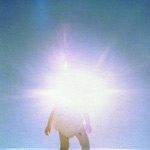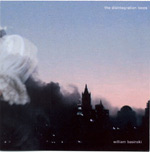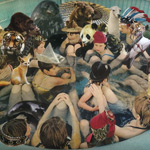——
——
 20. Boredoms
20. Boredoms
Vision Creation Newsun
[Warner Bros; 2000]
by Larry Fitzmaurice
Point: Vision Creation Newsun is great drug music. Drum-led reveries, acoustic fingerboard workouts, calls-and-responses, build-ups, come-downs, more thematic and emotional peaks and valleys than the California landscape, repetition after repetition after repetition — did I mention the songs are named after fucking shapes? All signs point to mushrooms, acid, hash, angel dust, cleaning solution — whatever you can get your hands on, really. Counterpoint: suggesting that Vision Creation Newsun was the product of any altered or self-manufactured state — that is, anything that doesn’t represent a clear-eyed, forward-thinking vision — would be robbing Boredoms of the enormous leap in both focus and expression that Vision Creation Newsun represents. From its forever-memorable opening arpeggios on, it’s the type of record that threatened to obliterate back catalogs (yes, even Super Ae), grand gestures (yes, even 77 Boadrum), and recent triumphs (Seadrum/House of Sun). Imitators falter, admirers fall speechless, and writers fumble in attempting to explain or describe its creation or existence (see: the past 162 words). Then again, the sense of awe is fitting: after all, nobody actually makes records like Vision Creation Newsun. Things like this just happen on their own.
• Boredoms: http://www.boredoms.jp
• Birdman: http://www.birdmanrecords.com
——
——
 19. Xiu Xiu
19. Xiu Xiu
Fabulous Muscles
[5 Rue Christine; 2004]
by Judy Berman
Sometimes one song can sum up a band’s entire body of work. For Xiu Xiu, Fabulous Muscles’s “I Luv the Valley OH” is that song. It began with a riff so modest as to be almost self-deprecating. Then, a hollow drum beat kicked in and Jamie Stewart started to howl like a smacked toddler. “It’s a pill, and you’ve got to take it,” he moaned. “It’s a pill that you’ve got to take/ It’s a pill, and you’ve got to take it/ I won’t rest until you take it/ It’s a heart that you made/ It’s a heart and the both of you made it/ It’s a heart that you made/ I won’t rest until you break it.” Stewart’s repetition wasn’t clumsy so much as neurotic, obsessive, gloriously imbalanced. The other songs on the album fit the same darkly humorous, bleakly sexual, all-around melodramatic mold that made “I Love the Valley OH.” But this was the song whose black romance, whose utter fleshly mortification, encapsulated the Xiu Xiu experience. Fabulous Muscles is the jewel in Xiu Xiu’s crown of thorns. This was not easy, clever indie rock; it was a noisy, difficult album that both hurt to listen to and, if you happen to be the right kind of masochist, made you enjoy that pain.
• Xiu Xiu: http://www.xiuxiu.org
• 5 Rue Christine: http://www.5rc.com
——
——
 18. Joanna Newsom
18. Joanna Newsom
Ys
[Drag City; 2006]
by Lukas Suveg
Although she was initially lumped into the mid-decade “freak folk” movement, Joanna Newsom demonstrated with Ys that she was in no way associated with the evanescent, loosely defined group of artists. Newsom’s debut, The Milk-Eyed Mender, already set her apart from her contemporaries, but the maturity and talent demonstrated on the subsequent Ys belied her youth and has already earned her a place in the upper echelons of American songwriters. It was a brazen action to release a five-song suite whose shortest track is seven minutes, especially coming from a young songwriter with both an idiosyncratic vocal style and proclivity for untraditional instrumentation, but with the assistance of a collaborative dream team (Jim O’Rourke, Steve Albini, Van Dyke Parks), Ms. Newsom sounded effortless. While her dazzling lyricism impressed with harp accompaniment alone (“Sawdust and Diamonds”), Parks’ orchestral text setting proved invaluable, evoking the singer’s vivid imagery through musical gestures ranging from beatific to menacing. But Newsom’s lyrical prowess and vocal delivery were the most indelible contributions to Ys. She knew her limits, but pushed them anyway, fearlessly disregarding critical approbation, which in turn produced one of the most compelling musical statements of the decade.
• Drag City: http://www.dragcity.com
——
——
 17. Cannibal Ox
17. Cannibal Ox
The Cold Vein
[Definitive Jux; 2001]
by David Morris
“My sound, mechanical, found ghost/ But my ghetto — Animal, found toast.” From that cryptic first couplet, The Cold Vein tracked the binary star of loss and hope that anchors underground hip-hop’s orbit. It’s easy to make a grim ghetto tombstone or a daisy-age visit to jamrock — The Cold Vein was great because its vulnerable mythology was matched by its embattled nihilism. Taking inspiration from the expressionism of 70s krautrock and electro, El-P’s beats were full of bent but motive melodies, with a layer of distortion that one-upped vinyl static as the grainy voice of the machine spirit. Over broken pianos and the blasted moans of disembodied voices, lyrics flipped from Jonathan Lethem pathos to Steven King grotesque in less than a breath: “If we can’t communicate, what we’ve got decays/ Until the smell gets more pungent… body parts falling apart.” Vast Aire and Vordul Megah were perfect for El Producto, because they were not afraid to feel pain or to desire — yet they still made you half-believe they were liable to eat your children in a fit of rage.
• Cannibal Ox: http://www.definitivejux.netjukies/cannibal-ox
• Definitive Jux: http://www.definitivejux.net
——
——
 16. Dirty Projectors
16. Dirty Projectors
Bitte Orca
[Domino; 2009]
by Brendan Mahoney
Even before David Longstreth sang “I think you’re more than a terrified witness/ Behind the arbitrary line” a minute into Bitte Orca, thick lines had been drawn and sides chosen between the Projectors’ latest incarnation and their back catalog, between the band’s believers and naysayers, between past rock music and the sonic universe encapsulated on this record. No fictional characters named Don Henley and no abstruse ballads about the fucking pigs here; Longstreth delivered it (relatively) straight and breezy, which turned out to be the most effective means of administering his peculiar brand of art-rock. Much of the credit belonged to the spectacular musicians supporting him, the sensuous body to Longstreth’s overreaching brain. You can realize in an intellectual sense that “Stillness is the Move” was influenced by Timbaland; you may experience brief flashing mental images of Jimmy Page on “The Bride”; and you are likely to exclaim “This song sounds exactly fucking the same as Nico’s ‘These Days’!” when “Two Doves” comes on. But Bitte Orca’s vision stands firm and apart, swallowing these influences in its confident embrace. The sound of a great band hitting its stride is always goosebump-inducing, an effect enhanced here by the internet rumbling that preceded the album’s release. You heard it was going to be special, you downloaded it, and you instantly knew it was.
• Dirty Projectors: http://www.dirtyprojectors.net
• Domino: http://www.dominorecordco.com
——
——
 15. Graham Lambkin
15. Graham Lambkin
Salmon Run
[KYE; 2007]
by S. Kobak
Some people need context to make sense of music that lacks rhythm, immediately discernible patterns, and conventional musicality. Without guidance, they lose focus and deem the piece of art “strange” or, even worse, “pretentious.” During the past year and a half, I played Salmon Run for anyone I thought would be open to the experience, and almost all of their initial reactions began with questions: What is he doing? Why do you enjoy this? Who is this guy? What they didn’t know was that the key to the album’s coherence resided in the crevices of Lambkin’s brain. Yes, he imagined the album with a specific goal in mind, but the artist’s intention should not necessarily factor into the listening experience. But for the devoted listener, Salmon Run transformed into a theater of daydreams. As it wormed its way through the listener’s consciousness, it painted pictures of madmen rampaging through opera houses, a residence settling as a lush composition plays, a jungle inside of a piano. Salmon Run was not toe-tapping music that you sing along to while vacuuming your living room. It created the vacuum in the room and you stepped inside.
• Graham Lambkin: http://www.myspace.com/graham_lambkin
——
——
 14. Fennesz
14. Fennesz
Endless Summer
[Mego; 2001]
by Mangoon
With all the renewed attention the nascent millennium has garnered for them, it’s likely the aughts will be remembered as the decade in which The Beach Boys eclipsed The Beatles in terms of sheer musical influence. No matter where you turned, it seemed acts were cutting their teeth chasing the Wilson brothers’ dreams of infinite beach bumming, whether through Animal Collective’s soothing vocal harmonies, the hypnagogic summer pop of Ducktails and Sun Araw, or the syrupy melodic anthems of The Ganglians. But before all that there was Fennesz’s Endless Summer, which ignited the impact that the Californian surf group’s tropical aesthetic would have on the decade. While previous outings had Fennesz working with actual Beach Boys audio, Endless Summer (a title recycled from one of their 1970s hits compilation) was pure homage. The shimmering textures of the 2001 record played like some half-remembered dream, drifting along the gentle ocean tide while the sun danced upon your closed eyelids. Digitally processed guitar blended the organic with the synthetic, blurring lines between the natural and technological world as crackling remnants of pop songs wafted like a sea breeze throughout. Endless Summer was in essence an album that proved noise could be beautiful and the beautiful could be noisy, that nostalgia could be timely, and it guaranteed that pop would never again need words to convey such heartrending emotions.
• Fennesz: http://www.fennesz.com
• Mego: http://www.editionsmego.com
——
——
 13. Dizzee Rascal
13. Dizzee Rascal
Boy in da Corner
[XL; 2003]
by Ajitpaul Mangat
Dizzee Rascal’s stunning debut album Boy in da Corner was steeped in conflict. Akin to the vehement postcolonial art of Coetzee and early-Kassovitz, Dizzee’s noisy adolescent fable was about the oppressed, the subaltern — about one of those countless stifled boys in da corner, about himself: a bombastic, punch-drunk, postmodern Caliban sitting at the crevices of London dishing the Grime. Despite being stuffed with a myriad of familiar combatants — thieves, rozzers, and shottas — the proceedings were far from generic; they were revelatory, for the conflict was innovatively internal. When Dizzee rhymes “Just remember this: I am you,” the lines between oppressor and oppressed smear together, so when Dizzee clashes with “juiced up” jezebels, feuding childhood mates, or a future that “ain’t right,” he was fighting both “you” and “I.” Even the very musical fabric was at conflict, as Dizzee’s anguished voice was nearly consumed by a modern sonic landscape filled with cacophonous ringtones and video game bleeps. Such adroit traversing of the politics of nature/nurture was all the more staggering considering its narrator’s adolescence. Ultimately, tragedy was escaped, perseverance reigned, eyes were not gouged — they remained wide open, while a novel, juvenile voice materialized via the art of rebellion: storytelling.
• Dizzee Rascal: http://www.dizzeerascal.co.uk
• XL: http://www.xlrecordings.com
——
——
 12. Animal Collective
12. Animal Collective
Merriweather Post Pavilion
[Domino; 2009]
by Benjamin Pearson
The aughts started off still riding a wave of pre-millennium tension and uncertainty about technology, electronics, and, ok, computers. In Grandaddy’s 2000 release Sophtware Slump, household appliances in a national forest made us sad because they broke a sacred dichotomy of the technological and the natural. Their sounds, like a lot of music, seemed to be saying the same thing; the bleeps and the finger plucks may have danced close, but they never went all the way. Yet, as the decade closed, we’d clearly come a long way: the best outdoors album was nearly all electronic. Merriweather Post Pavilion wasn’t the sound of nature and digital getting it on; it was the sound of them settling down, starting a family, and living life together. Avey Tare and Panda Bear sang about timeless themes like existence, touching someone they love, or how nice adobe is; meanwhile, far from calling attention to itself as other, the web of noise just helped make their words seem more meaningful. Maybe it’s too much to say that Merriweather Post Pavilion perfectly captured our post-dichotomy relationship with technology at the end of the decade. Then again, if an album can make Yes’ “We Have Heaven” (from Fragile) sound cool (see 2:25 into “Summertime Clothes”), I wouldn’t underestimate it.
• Animal Collective: http://www.myanimalhome.net
• Domino: http://dominorecordco.us
——
——
 11. Ghostface Killah
11. Ghostface Killah
Fishscale
[Def Jam; 2006]
by Joe Davenport
Back in 2006 when Fishscale dropped, I had all but given up on the Wu. Aside from Ghostface’s other triumph in 2000 (Supreme Clientele), there hadn’t been anything out of their camp that had hit me the way records like Enter the Wu-Tang (36 Chambers), Ironman, Nigga Please, Only Built For Cuban Linx, and Liquid Swords had when I was in high school. Fishscale changed that. From the album’s groggy intro to the near-perfect one-two punch of “Shakey Dog” and “Kilo,” Ghostface sounded hungry and fierce. One minute he was reminiscing about childhood punishment (“Whip You With A Strap”) and the next he was barking at a barber to be careful with a haircut because he’s “goin’ bald on top” (“Barbershop”). How many other rappers can get away with that? Don’t even get me started on the breezy and brilliant “Underwater.” The presence of both DOOM and the late J Dilla as producers (rather than the RZA) spoke to just how much the album was of its time. And while the 2000s saw a fair share of coke rap, on Fishscale Ghost didn’t let it get in the way of his masterful storytelling; he instead used it as just another backdrop for a long-running narrative about real life that’s persisted throughout most of his work.
• Ghostface Killah: http://www.ghostfacekillah.com
• Def Jam: http://www.defjam.com
——
——
 10. William Basinski
10. William Basinski
Disintegration Loops
[2062; 2003]
by Keith Kawaii
Disintegration Loops was a perfect example of an album’s narrative completely shaping its perception. Like most, I was introduced to the work through its connection to 9/11, and the imagery of Basinski blaring his loops across a smoke-filled New York skyline has never left me. I can only assume that my own experience with those loops was common: they became an aural monument to the tragedy of 9/11, a crystallization of the events through sound. Connecting this sprawling piece to such a horrible act was a very human impulse, spun from the desire to compartmentalize an experience and covet a linear narrative that might obscure the chaos of real life. In my mind, the work instantly became something “more” than four albums pressed to and released on CD. It served a personal and collective experience in a way that records rarely do. Through loss, the mythology of Disintegration Loops was perpetuated, and its simple yarn allowed typical album/culture trappings to fall away. Basinski’s method of looping sounds endlessly — and letting the aleatoric results comprise the finished work — further separated the artist from his art; in fact, it appeared as non-art, the antithesis of ego, filled with illusions of eternality instead of opportunist rockisms. For me, that sheen of endless purity has allowed an inherently flawed pretense — that Disintegration Loops was somehow above the work of a single man — to serve a deeply cathartic purpose: reliving tragedy without the full sting of reality.
• William Basinski: http://myspace.com/williambasinski
• 2062: http://www.mmlxii.com
——
——
 09. Black Dice
09. Black Dice
Beaches and Canyons
[DFA; 2002]
by Matt Weir
Beaches and Canyons contributed most heavily to psychedelic music in the 00s, no doubt about it. I listen to this album and hear a better (and earlier) version of all of the “ecstatic release” drumming, layered synth gurgle, and Nature-aping aesthetic crisscrossing the semi-baked underground over the last seven years. But it really is like comparing the video game version to the book here, people. Few groups have the ambition required to make a record this expansive, so Beaches and Canyons still sits weirdly untouched. The album’s true value was found in the audacious drama packed into every moment. Each track simultaneously goaded and lulled the listener with seemingly unstructured sounds until a Hisham Bharoocha drum beat, a well-placed synth bleat, or a crying-baby sample transformed the whole piece into a shimmering Smashed Horizon. I have to go back to The Dead C’s “Driver UFO” to find such sprawling and patient dynamics. Finally, album closer “Big Drop” took the tension and release back in time to the band’s thrash-feedback roots, starting with ominous coos and tremelo-soaked guitars, taking detours into Melvins-style drum riffs, and then dunking the song head first in their 1997 hostile concerns. Thrilling. And better than 95% of movies.
• Black Dice: http://www.blackdice.net
• DFA: http://www.dfarecords.com
——
——
 08. Panda Bear
08. Panda Bear
Person Pitch
[Paw Tracks; 2007]
by Gumshoe
Person Pitch filled needs I didn’t know I had. I was not alone. It was almost like a “Where do we go from here?” kinda thing. Panda Bear sampled and looped like Prince Paul, pulling in all he could from the outside world like only a former record-store stooge could — in the album’s booklet, he made a list of the specific artists’ troughs he wet his beak in — and spitting it back out with his trademark style tattoo’d all over it. With albums like this and Sung Tongs, the AC crew got us all ready for Major Lazer and Weekend, Vampire. But it was more than that. Person Pitch was the most significant album of 2007, by a wide-ass margin, and a key point in the development of Animal Collective, as Panda Bear convinced Avey Tare the methods he used to make Pitch would serve their troupe well. The result was Merriweather Post Pavilion, one of the only other recent albums even in the same ballpark. But there’s one thing you can get from Person Pitch that you can’t get from any of the proper AC albums: pure Panda compositions, an uninterrupted set of melodies from the man who conjured skeletal seedlings like “Winters Love” and “Derek” into fruition. And wouldn’t you know it? Panda Bear, nee Noah Lennox, came through in the clutch, as so few in a position of unrivaled hype do. This was where dub, calypso, afrobeat, indie, noise, drone, and IDM not only intersected, but got digested by more than just a few thousand in the underground. If you think about what happened in 2008 and 2009, Person Pitch only grows in paw-tracked prominence.
• Panda Bear: http://www.myspace.com/pandabear
• Paw Tracks: http://www.paw-tracks.com
——
——
 07. Godspeed You Black Emperor!
07. Godspeed You Black Emperor!
Lift Your Skinny Fists Like Antennas To Heaven
[Constellation; 2000]
by D-BO
What is there to be said of the “post-rock” holy grail and its binding word? Most famous for featuring the longest melodic buildup and orgasm heard around the underground world, Godspeed You Black Emperor!’s Lift Your Skinny Fists Like Antennas to Heaven was a musical revelation, a record that took the overwrought teleology of post-rock and provided a political bent to what would otherwise signify pure aesthetics. I swooned over each crescendo and nodded in agreement with each sampled vocal track — the phrase “they don’t sleep there anymore on the beach” never sounded so pained, so sorrowed. Seeing the material live was an even deeper experience. Stringed instruments brooding over effects pedals, the group performed with grimness and beauty unmatched. I’ll always remember the black-and-white video footage of a simple scene at a Wal-Mart that served as the backdrop. By itself, the video would’ve seemed relatively harmless, but paired with Godspeed You Black Emperor!’s music, it was something fucking sinister.
• Godspeed You Black Emperor!: http://www.brainwashed.com/godspeed
• Constellation: http://www.cstrecords.com
• Kranky: http://www.kranky.net
——
——
 06. Deerhoof
06. Deerhoof
Reveille
[5 Rue Christine; 2002]
by PSRE
Reveille marked a decisive pivot between modes of American experimentalia, the crumpled grab bag at the interstices of maxed-out free rock, and the queasy negotiation of freedom from it. The record unfolded as a series of violations — from genre, sure, but more pointedly from the basic elements of composition. Ideas dove in and splattered, boisterously enacted but never clung to. Deerhoof’s sui generis melodic logic maneuvered at high registers of abstraction, Satomi Matsuzaki’s vocal interventions shunning affect or inflection but transmitting all the show-don’t-tell mania of a kindergarten-age Max Ernst. The machinery, meanwhile, couldn’t be stopped, drummer Greg Saunier’s springy, savage virtuoso subject to cannibalistic heaves in and out of meter. Over 16 dementedly varied tracks, we take a searching tour filled with hard lefts, devil-may-care truncations, and ineffable fun at the precipice dividing smooth from striated iterations of weirdness. Call it an archaeology of the modern song. With Reveille, Deerhoof’s restive genius sidled out of the fog for confused inspection, and seven years later, we surrender, durably exhausted by their curiosity: Were they asking or telling?
• Deerhoof: http://www.myspace.com/deerhoof
• Kill Rock Stars: http://www.killrockstars.com
——
——
 05. The Microphones
05. The Microphones
The Glow, Pt. 2
[K; 2001]
by Jason P. Woodbury
I first heard The Glow, Pt. 2 under the most clichéd of circumstances. I had been dumped and spent my nights sleeplessly listening to Rumours alone in my room, in the cavernous two-story house I shared with a rotating cast of lifelong friends and would-be-criminals, when a friend sent me the record with the express intent of exploding my head. I had heard The Microphones before, but what I heard didn’t echo the gentle pop I was vaguely familiar with. Employing detailed production, mastermind Phil Elverum bounced gorgeous, stereo-panned acoustic guitars against blown-out drums, fuzzy keys, infinitely tracked vocals, and swelling noise. Elverum’s raw-nerve sentiments were protected by murky layers of sound, and he delivered existential truths like I’m small, I’m small, we are all with dizzying beauty. Great “Bummer Records” help cement the feeling of self-pity and encourage the childish impulse to wallow in it. The Glow, Pt.2 does not qualify, because blasting it through headphones, it’s impossible not to feel blood coursing through veins, illustrating an intense sense of purpose, the imagery suggesting a natural nobility in the act of survival.
• The Microphones: http://www.pwelverumandsun.com
• K: http://www.krecs.com
——
——
 04. Madvillain
04. Madvillain
Madvillainy
[Stones Throw; 2004]
by Jay Dryburgh
Some days it feels as if the past decade was far too favorable to villains — not bumbling Austin Powers henchmen, but the ones sinister enough to force a smile on you with a knife, bilk you in a Ponzi scheme, or sign in dubious domestic policy. To a point, it’s the haymakers of reality that made the one-hitter jabs of Madvillainy so palatable. MF Doom’s off-kilter flow created surprise where his rhymes didn’t, popping against the groove of Madlib’s brass lines and organ haunts. ‘Lib looped gorgeous soul samples as easily as he borrowed from L.A. beat wizard Daedelus. But it was the philosophy of afrofuturist Sun Ra on “Shadows of Tomorrow” that allowed the listener to penetrate the depths of the lair. “Shadows” was rife with mortal panic, conceding “the perfect man of the past is made according to the rule of the past,” which is also how we label a villain. And while history is not always kind to subversive types, any truly fearsome bad guy refuses to play by the rules; and that, in essence, is what separates “America’s Most Blunted” from ordinary G’s.
• Madvillain: http://www.stonesthrow.com/madvillain
• Stones Throw: http://www.stonesthrow.com
——
——
 03. Lightning Bolt
03. Lightning Bolt
Wonderful Rainbow
[Load; 2003]
by Chizzly St. Claw
Never have we sweated as we throbbed on the concrete in front of these Brians on tour. Brian Gibson and Brian Chippendale are able to create legendary live performances and multi-day eardrum aftershocks that would be seemingly impossible to rival on record. Yet Wonderful Rainbow was not only able to match the intensity of the live show and outdo its predecessor (Ride the Skies), but it created such a vibrant world of frenetic and brilliant ear destruction that successive efforts have had an impossibly hard time living up to that standard. Truly, Lightning Bolt took an idea, a vision of music so full and noisy that it defied reason given the simplistic bass/drums format, and turned it into a symphony that was both evil and beautiful. Born of Fort Thunder, they captured the spirit of that eternally influential Providence noise rock scene in an exemplary fashion, and the masks, art, noise, and anarchy have been immortally preserved through their efforts on Wonderful Rainbow. Each melodic passage was so memorable and precise, bugling and contorting the premise of a rock song with vile nihilistic aplomb. We must pray that the apocalypse sounds like Lightning Bolt. Because then we might maintain.
• Lightning Bolt: http://laserbeast.com
• Load: http://www.loadrecords.com
——
——
 02. Animal Collective
02. Animal Collective
Sung Tongs
[Fat Cat; 2004]
by Nobodaddy
In the sticky, idling mid-summer of 2004, entire life perspectives were forever changed… by meowing kitties. I remember exactly how it happened for me. Halfway through the existentially excruciating mind-fuck that is undergrad school, searching for a stride in a fatally-doomed rock band, working a shitty summer job, exponentially losing touch with childhood friends, and spending entirely too many early-morning hours in the nicotine-stained haze of a standard-issue “all-night diner,” I, like many adolescents my age, felt thoroughly lost in the densest thicket of Quarter-Life’s woods. Luckily, in those same woods was a foggy clearing; in that clearing was a tumbledown leaf house; and inside that leaf house were two blissfully marooned Lost Boys. There, in their sanctuary, deliriously strumming, stomping, panting, and purring through a batch of irreproachably childlike compositions, this incorrigible runaway club (known unrestrictedly as Animal Collective) demonstrated remarkably that the “bewilderment” we often encounter as we leave adolescence behind is just one, tiny little swoosh of striped-tiger face paint away from “exhilaration.” They even suggested that we didn’t have to go to college and grow up at all if we didn’t want to. Granted, I didn’t exactly notice a dramatic dip in class attendance when I returned to school that fall, but it was somehow enough just to know that we had the option.
• Animal Collective: http://www.myanimalhome.net
• Fat Cat: http://www.fat-cat.co.uk
——
——
 01. Radiohead
01. Radiohead
Kid A
[Capitol; 2000]
by Willcoma
It was 2000, and I was in a quad on Pace campus with five people living in an approximately 12x24 ft. room divided by a concrete T. One night, a bootleg of Kid A came on surprisingly loud. Nobody complained. One of my roommates had it on repeat, and since it was just a little too loud to sleep to, I listened to the album well into the morning. I laid there mesmerized by an utterly free-sounding pop record by a band that, while merely maudlin to some, was just as easily immense and brilliant to others.
Thom Yorke really broke out on Kid A, letting his voice work as a fearsome, alien instrument while also allowing space for non-vocal passages to bring dramatic momentum. It had perfect sequencing with a perfect feel, like vivid shocks of silver glaring through holes in the snow-covered mountain range. There was a severe, overpowering bleakness throughout, shot through with purpose and all the swaying power of a bad infection. Many albums have given this musical decade its sanguinary, silken pig shape, but perhaps none more than this monsoon-sized spin cycle of digital ash.
And now we’re all in a bunker. While space is certainly tight down here, we can all stop scrambling over one another long enough to agree that this is the definitive post-2k release. It’s all well and good to be heart-on-your-sleeve and melodically saccharine, and many have capitalized on this for decades — but only Radiohead have dared take their mainstream allure and wrap it in dense steel-wool layers of gauze. Not only was this an impeccably orchestrated album, but it was one that felt vaguely unwieldy. It remains a testament to the strange, beguiling power of mystery and intrigue without a singular name. It doesn’t spell out our new century per se, but it helps to shape it in a fashion that’s both stark and transcendently gorgeous. Long may Kid A move us and the generations of listeners to come.
• Radiohead: http://www.radiohead.com
• Capitol: http://www.capitolrecords.com
——
——
